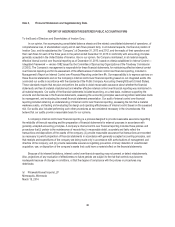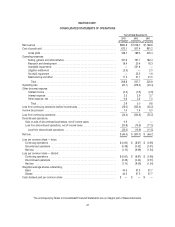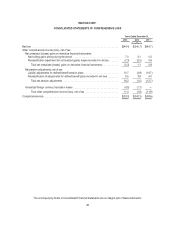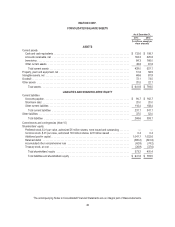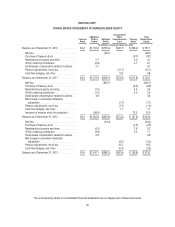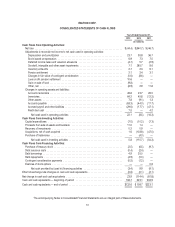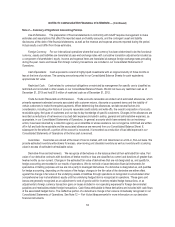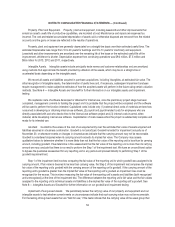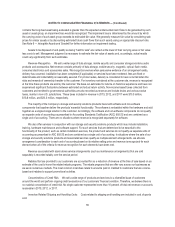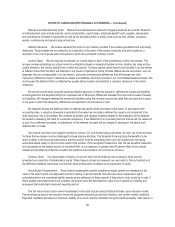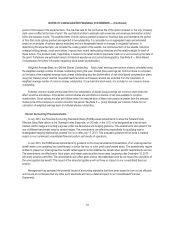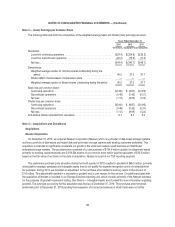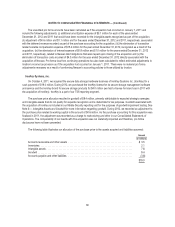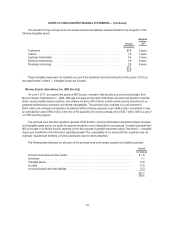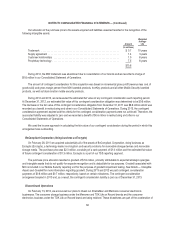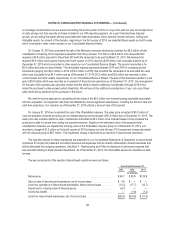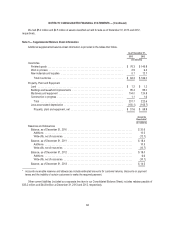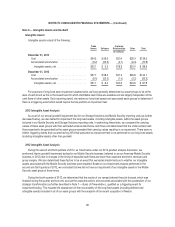Memorex 2013 Annual Report Download - page 58
Download and view the complete annual report
Please find page 58 of the 2013 Memorex annual report below. You can navigate through the pages in the report by either clicking on the pages listed below, or by using the keyword search tool below to find specific information within the annual report.NOTES TO CONSOLIDATED FINANCIAL STATEMENTS — (Continued)
contains the long-lived asset being evaluated is greater than the expected undiscounted cash flows to be generated by such
asset or asset group, an impairment loss would be recognized. The impairment loss is determined by the amount by which
the carrying value of such asset group exceeds its estimated fair value. We generally measure fair value by considering sale
prices for similar assets or by discounting estimated future cash flows from such assets using an appropriate discount rate.
See Note 6 — Intangible Assets and Goodwill for further information on impairment testing.
Assets to be disposed of and qualify as being “held for sale” are carried at the lower of their carrying value or fair value
less costs to sell. Management judgment is necessary to estimate the fair value of assets and, accordingly, actual results
could vary significantly from such estimates.
Revenue Recognition. We sell a wide range of data storage, mobile security and consumer storage solutions audio
products and accessories. Net revenue consists primarily of data storage, mobile security, magnetic, optical, flash media,
consumer electronics and accessories sales. We recognize revenue when persuasive evidence of an arrangement exists,
delivery has occurred, installation has been completed (if applicable) or services have been rendered, fees are fixed or
determinable and collectability is reasonably assured. For product sales, delivery is considered to have occurred when the
risks and rewards of ownership transfer to the customer. For inventory maintained at the customer site, revenue is recognized
at the time these products are sold by the customer. We base our estimates for returns on historical experience and have not
experienced significant fluctuations between estimated and actual return activity. Non-income based taxes collected from
customers and remitted to governmental authorities are also recorded as revenue and include levies and various excise
taxes, mainly in non-U.S. jurisdictions. These taxes included in revenue in 2013, 2012, and 2011 were $10.3 million,
$13.8 million, and $20.3 million, respectively.
The majority of the Company’s storage and security solutions products have both software and non-software
components that together deliver the products’ essential functionality. The software is embedded within the hardware and sold
together as a single storage solution to the customer. Accordingly, the software and non-software components do not qualify
as separate units of accounting as prescribed in Accounting Standards Codification (ASC) 605-25 and are combined as a
single unit of accounting. There are no situations where revenue is recognized separately for software.
We also offer services in conjunction with our storage and security solutions products which may include installation,
training, hardware maintenance and software support. For such services that are determined to be essential to the
functionality of the product, such as certain installation services, the product and services do not qualify as separate units of
accounting as prescribed in ASC 605-25 and are combined as a single unit of accounting. In situations where the sale of our
storage and security solutions products and associated services qualify as multiple element arrangements, we allocate
arrangement consideration to each unit of accounting based on its relative selling price and revenue is recognized for each
element when all of the criteria for revenue recognition for such elements have been met.
Revenue associated with stand-alone service arrangements (such as maintenance arrangements) that are sold
separately is recorded ratably over the service period.
Rebates that are provided to our customers are accounted for as a reduction of revenue at the time of sale based on an
estimate of the cost to honor the related rebate programs. The rebate programs that we offer vary across our businesses as
we serve numerous markets. The most common incentives relate to amounts paid or credited to customers that are volume-
based and rebates to support promotional activities.
Concentrations of Credit Risk. We sell a wide range of products and services to a diversified base of customers
around the world and perform ongoing credit evaluations of our customers’ financial condition. Therefore, we believe there is
no material concentration of credit risk. No single customer represented more than 10 percent of total net revenue or accounts
receivable in 2013, 2012, or 2011.
Inventory Related Shipping and Handling Costs. Costs related to shipping and handling are included in cost of goods
sold.
55



